In the first four rounds of our Handgun Showdown series, we’ve been comparing different Glock pistols, then in round 5 we compared two Saturday Night Specials both manufactured by Cobra Enterprises. Today we’re taking a look at two SIG Sauer pistols: the full-size SIG P226 vs. compact SIG P229, both modular pistols that can be chambered for the same three handgun calibers 9mm, .357 SIG and .40 S&W and popular among law enforcement officers, the military and civilians.
Table Of Contents
The Tale of the Tape – SIG P226 vs. SIG P229
| P226 | P229 |
|---|---|
| Caliber: 9mm, .357 SIG, .40 S&W | Caliber: 9mm, .357 SIG, .40 S&W |
| Overall Length: 7.7 in | Overall Length: 7.1 in |
| Height: 5.5 in. | Height: 5.4 in. |
| Width 1.5 in. | Width 1.5 in. |
| Barrel Length: 4.4 in. | Barrel Length: 3.9 in. |
| Weight with empty mag: 34.4 oz | Weight with empty mag: 29.6 oz |
| Frame Material: Alloy | Frame Material: Alloy |
| Grips: Black Synthetic | Grips: Black Synthetic |
| Sight Radius: 6.30 in. | Sight Radius: 5.70 in. |
| Action: DA/SA | Action: DA/SA |
| Barrel Rifling Grooves: 6 | Barrel Rifling Grooves: 6 |
| Rifling Length of Twist 9mm: 1 in 10 in. .357 SIG: 1 in 16 in. .40 S&W: 1 in 16 in. | Rifling Length of Twist 9mm: 1 in 10 in. .357 SIG: 1 in 16 in. .40 S&W: 1 in 16 in. |
| Mag Capacity 9mm: 15 rounds .57 SIG: 12 rounds .40 S&W: 12 rounds | Mag Capacity 9mm: 15 rounds .57 SIG: 12 rounds .40 S&W: 12 rounds |
If by looking at the SIG P226 vs. SIG P229 tables above you think to yourself that there’s not much difference between the P226 and the P229, you are probably correct.
Both have practically the same frame dimensions, the same exact magazine capacity, the same frame, and slide material, the same SA/DA trigger pull weight, and the same number of rifling grooves and rifling length of twist. Even the calibers they can use are the same.
And they both have the same accessory rail for laser and flashlight attachments.
The only real differences between them are their barrel, slide, and sight radius lengths. So what gives?
Here we go again…
If you haven’t been following our series of handgun showdowns, you might want to. In round 1, we discussed the differences between the Glock 22 and the Glock 23. Both are practically the same pistols chambered for the .40 S&W. The only things different between them are their barrel and slide lengths and their magazine capacity.
Well, for this round – SIG P226 vs. SIG P229, both SIG Sauer pistols being compared have the same magazine capacity despite one being a tad smaller than the other. But both pistols can be bought chambered in one of three different handgun calibers: 9mm, .357 SIG, and .40 S&W. That’s what’s so different this time.
When Does SiG Size Matter?
Let’s say you’re a first-time buyer, and you’ve read somewhere on the Interwebz that these SIG pistols (particularly the full-size P226) used to be the standard sidearm for the Navy SEALs and you decided you want one (even when you know that for some odd reason, the Navy SEALs replaced them with the Glock 19).
You browse through SIG Sauer’s website and find out that the P226 has a smaller compact brother (technically, “compact” in these contexts is incorrect — it’s supposed to be labeled “mid-size”) called the P229. Now you’re getting confused — which one would you buy if both are practically the same pistols, both have the same round count and both are priced the same?
What is the Difference Between a SIG P226 vs. SIG P229?
We all know that a handgun with longer slide and a longer barrel will have a relatively softer recoil, and better recoil control will result to faster re-acquisition of sights and faster follow-up shots. A longer sight radius will also result in more accurate shots.
But we also know that a shorter grip won’t print easily, so guns with shorter grips will be easier to carry concealed.
So it looks like the P226 has two things going for it, while the P229 only has one. Does this mean the P226 is going to be the better option? Let’s find out.
SIG Handgun Calibers and Recoil
Just so you’ll have an easier time deciding, let’s see how having a longer slide and barrel and more weight will favor the P226 as far as recoil control in all of the three handgun calibers it will chamber.
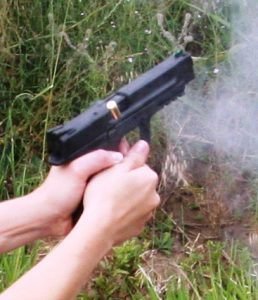
The powder burns quickly, creating an astronomically high amount of pressure (take note of this part) which results in the bullet being pushed out the only available direction — towards the muzzle.
As the bullet is pushed out of the cartridge and out of the muzzle, it pushes the slide in the opposite direction — towards the person holding the gun (take note of this part too). The slide absorbs some of the force of recoil by ejecting the empty cartridge and re-cocking the hammer.
Sig Spring Load Cycle
The recoil spring won’t let the slide rest in its rearward position so it pushes the slide forward (or it pulls it back to its original position, whichever way you want to look at it), and on its way to full battery the slide snags a fresh cartridge protruding from the lip of the magazine and pushes it into the chamber, thus completing the whole cycle. The handgun is then ready for another shot.

This astronomically high amount of pressure varies across different handgun calibers. This pressure sets four things in motion at the same time (but because our human senses can only perceive too many things happening at once, we see it in this sequence):
Effects of Pressure
- It pushes the bullet out of the muzzle, and the bullet will hit whatever’s in front of it, for better or for worse.
- It pushes the slide rearward so it can do its job — eject the spent case and re-cock the hammer (thereby indirectly putting tension to the main spring).
- By pushing the slide rearward, it indirectly loads the recoil spring with energy. Springs by design don’t want to be bothered by any external forces acting upon them so they will always try to revert to their original state. The spring releases the energy, pushing the slide forward, and in the process the slide loads the chamber with another round.
- The remaining force from the pressure pushes the frame and grip of the handgun towards the hands of the person who pulled the trigger — this is what’s known as recoil.
Because this pressure varies depending on a few things, let’s look at how each of the handgun calibers would recoil when fired from either handgun.
Ballistic Performance, Recoil Velocity and Energy Specs for SIG P226 vs P229
| Caliber | 9mm | .357 SIG | .40 S&W |
|---|---|---|---|
| Bullet Weight (in gr.) | 115 | 125 | 165 |
| Muzzle Velocity (in fps) | 1,300 | 1,500 | 1,130 |
| Powder Charge Weight (in gr.) | 7.2 | 7 | 7.5 |
| SIG P226 Weight (in oz.) | 34.4 | 34.4 | 34.4 |
| SIG P229 Weight (in oz.) | 29.6 | 29.6 | 29.6 |
| SIG P226 Recoil Velocity (in fps) | 12.33 | 14.78 | 14.88 |
| SIG P226 Recoil Energy (in ft.lbf) | 5.08 | 7.3 | 7.4 |
| SIG P229 Recoil Velocity (in fps) | 14.32 | 17.18 | 17.29 |
| SIG P229 Recoil Energy (in ft.lbf) | 5.9 | 8.49 | 8.6 |
From the table above, we can see that a bullet’s weight and velocity and the powder charge used are all directly proportional to both recoil. The heavier a bullet and the more powder charge used to send it flying at higher velocities, the more the gun recoils.
We can also see that the weight of a firearm is inversely proportional to recoil. The heavier a gun is, the less it recoils.
For all the people out there who have trouble with Physics or Math, I created some charts to better illustrate these points.
SIG P226 vs P229 – Recoil Velocity
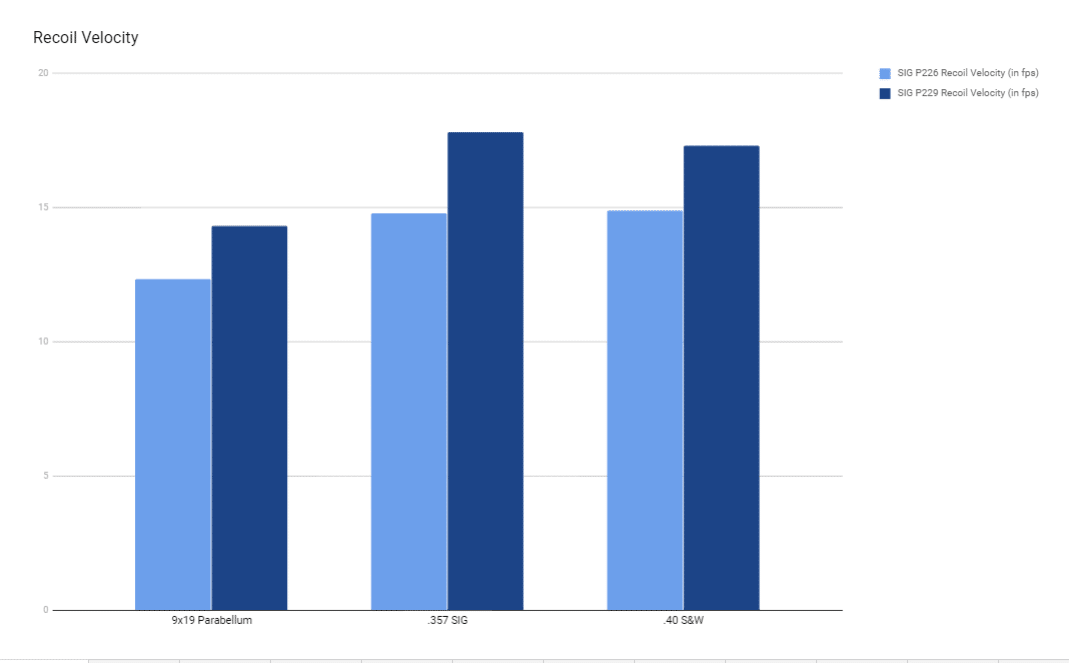
Imagine being able to fire a gun without even holding it and without your index finger pulling the trigger. The force of the recoil from shooting the 9mm will send the SIG P226 flying 12.33 feet in a second. The same force will send the SIG P229 flying 14.32 feet in a second. That’s a ~13.8% difference in recoil velocity between the two.
Doing the same math for the .357 SIG, the force of the recoil from shooting the .357 SIG will send the SIG P226 flying 14.78 feet in a second, and the same force will send the SIG P229 flying 17.18 feet in a second, a ~13.9% difference in recoil velocity between the two pistols.
For .40 S&W, the force of the recoil from shooting the .40 S&W will send the SIG P226 flying 14.88 feet in a second, and the same force will send the SIG P229 flying 17.29 feet in a second, again a ~13.9% difference in recoil velocity.
The consistent ~13.9% recoil velocity difference between the SIG P226 and SIG P229 is relatively low when comparing recoil velocities from the same handgun caliber. What this means is the difference in recoil velocity between the two handguns is negligible assuming both are chambered for the same caliber (unless you’re really having trouble aiming after a follow up shot).
Let’s do things a little differently. We’ll not be including the .357 SIG this time because its recoil velocities are pretty much the same as the .40 S&W’s.
40 Cal SIG P226 vs P229
If we compare recoil velocities between a SIG P229 chambered for the .40 S&W (17.29 fps) and the same SIG P229 chambered for the 9mm (14.32 fps), the difference is ~17.17% in recoil velocity. This means there won’t be much difference in accuracy and sight re-acquisition when shooting any of the three handgun calibers using the same mid-size pistol.
What if we compare the recoil velocity between a SIG P226 chambered for the 9mm and a SIG P229 chambered for the .40 S&W? We get a difference of ~28.68% in recoil velocities. This means if you’re comfortable shooting a full-size 9mm pistol and you decided to try a mid-size .40 S&W, you might find it harder to shoot the mid-size pistol as fast and as accurately. We’ll get more into this later.
Recoil Energy
Recoil energy is different from recoil velocity.
To spare everyone all the headache from trying to make sense of it, I view recoil velocity as how fast the gun would move upon recoil when fired from open space (like if it was hanging in the air and it wouldn’t be affected by any type of friction), while I view recoil energy as that force I feel in my hands whenever I fire a gun. Simply put, recoil energy to me is what other people call “felt recoil”.
Because we’re all differently built on a physiological level, we’ll all have varying levels of strength. The only body parts that get punished a lot when shooting heavy-recoiling handguns are the strong hand (not so much the supporting hand) — specifically that web between the thumb and the index finger, and the wrist. Thus, we will all react differently to a gun’s recoil energy.
The long and short of it: a higher recoil energy means a more painful shooting experience, while a higher recoil velocity means higher muzzle rise, slower re-acquisition of sights and slower follow-up shots.
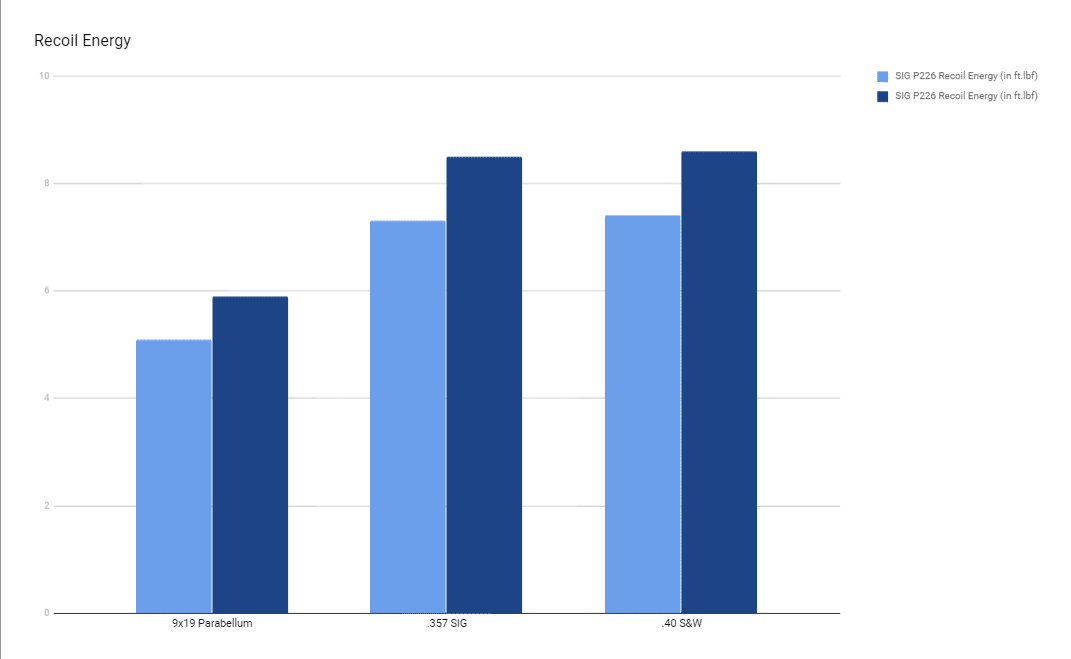
From the shape of the graph, we can already see that the 9mm has significantly less recoil energy compared to the other two handgun calibers when fired from either a SIG P226 or P229. We can also see that the .357 SIG and the .40 S&W have about the same recoil energy.
Let’s Crunch the Numbers to Get to the Specifics.
Comparing a SIG P226 and a SIG P229, both chambered for the same caliber, we’ll get the following results: for the 9mm, a ~13.9 difference; for the .357 SIG, a ~14% difference, and for the .40 S&W, again a ~13.9% difference. Again, this means there is negligible recoil difference between the two handguns when both are chambered for the same handgun caliber.
Comparing two SIG P229s, one chambered for .40 S&W and the other chambered for 9mm, we get a difference of 31.39% in recoil energy. That is quite a bit of felt recoil. But it simply means the .40 S&W is a potent round and will have more felt recoil compared to a 9mm when fired from a mid-size pistol.
Comparing SIG P229 chambered for .40 S&W and SIG P226 chambered for 9mm, the difference in recoil energy is 40.93%. This means if you’re comfortable with a full-size 9mm and you’ve never fired a mid-size .40 S&W handgun before, you might hurt your hands if you decide to switch to the smaller handgun.
So What’s the Verdict Between Sig p226 and Sig p229?
Here are some things to consider before purchasing either of the two pistols:
Best Sig for Recoil
The difference in recoil velocities and recoil energies between the two handguns is negligible assuming both are chambered for the same caliber. So if you’re wondering whether you should get a P226 or a P229 as a CCW for self defense (in whichever of the three handgun calibers available that you prefer), chances are the P229 will be the better option for you.
If you’re comfortable with the .40 S&W’s or the .357 SIG’s recoil, it won’t matter which pistol you choose. Both the SIG P226 and P229 will handle recoil well.
If you’ve only ever shot full-size 9mm handguns and you’re looking to buy your first handgun in .40 S&W, you might find the SIG P229’s recoil unpleasant, maybe even painful if you’re recoil-shy. Go to your nearby range, rent it and try shooting it first. If you don’t like the way it recoils, it’ll make more sense to purchase the SIG P226.
The slightly longer barrel, slide, and sight radius of the P226 making the gun a bit more accurate still holds true. However, only to a small extent. Considering how all the three calibers it can chamber are primarily used in self defense situations where people instinctively point and shoot, I highly doubt that an extra 0.5 inch would offer any significant advantage. If anything it only makes the P226 a bit harder to conceal.
Sig P226 & Sig P229 For Sale
Before we reveal our winner between the Sig P226 and P229, you can compare the prices from our favorite merchant.
| Product Name | Where to Buy | |
|---|---|---|
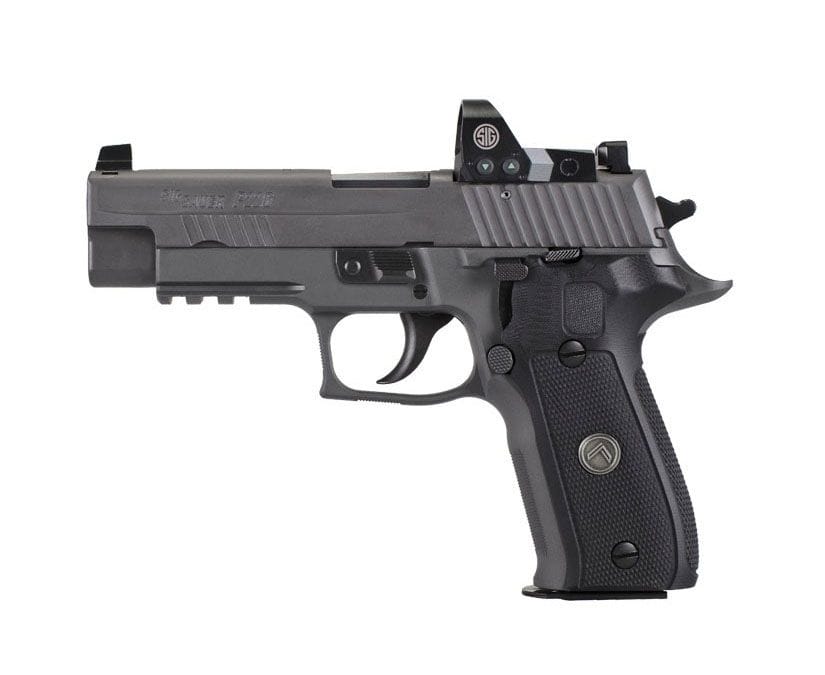 | SIG SAUER P226 LEGION 9MM | |
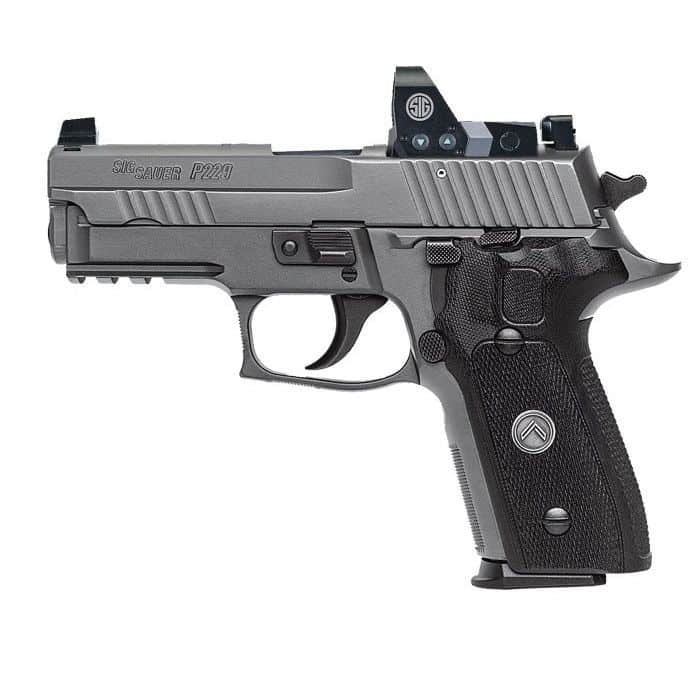 | SIG SAUER P229 LEGION RX COMPACT 9MM |
The Perfect Sig P226
SIG SAUER P226 LEGION 9MM. w Reflex Optic
The Perfect Sig p229
SIG SAUER P229 LEGION RX COMPACT 9MM PISTOL w Reflex Optic
SIG P226 vs. SIG P229 – Conclusion
As far as I’m concerned, SIG Sauer is cannibalizing their P226 with their P229.
Due to the fact that the relatively smaller SIG P229 has the same ammo capacity as the SIG P226, and there is very negligible difference between the two handguns as far as handling and recoil control, I don’t see the point in buying a SIG P226.
The P229 also having a smaller grip area will be a bit easier to conceal. But if for some reason, you have ginormous hands. Which makes you think you won’t get a solid purchase on the smaller grip, the P226 will be the better option.
Also, if you play IPSC or IDPA and you need all the advantages you can get from a slightly heavier handgun with a longer slide, barrel, and sight radius. Assuming you’re a cheapskate that an STI double-stack 2011 in .38 Super would be way too expensive for you. These are the only two handguns you can choose from. Then by all means get the P226.
Personally, I just don’t see the point in getting the full-size P226. Considering the mid-size P229 does everything it can do. It is relatively easier to conceal, has the same mag capacity, and costs the exact same $$$.
I think anyone who can make sense of all the graphs I put above. Let alone all the Mathcraft I did would agree that all things considered, the P229 wins over the P226.
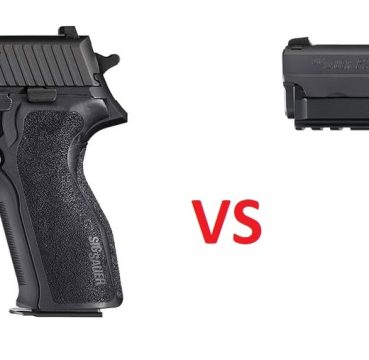


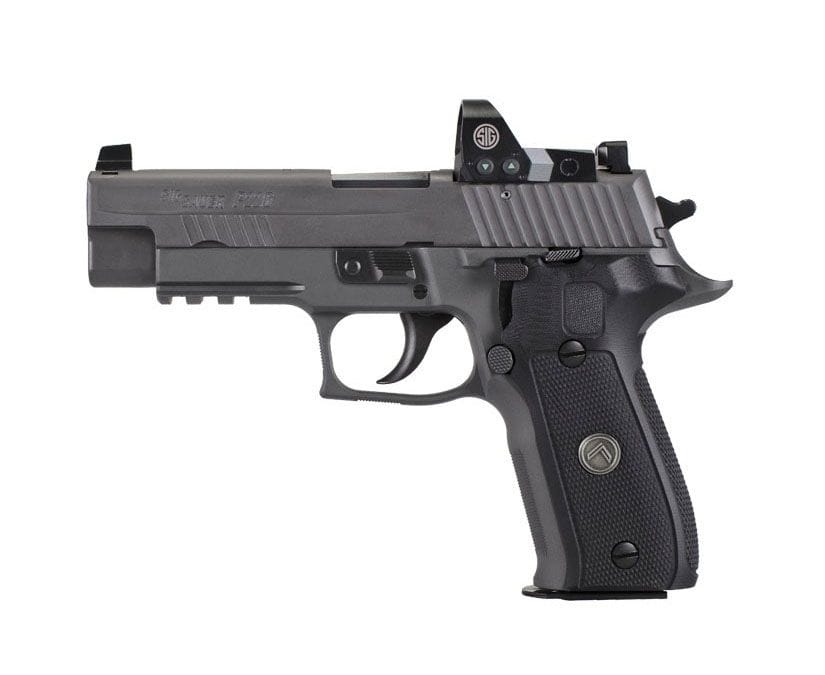
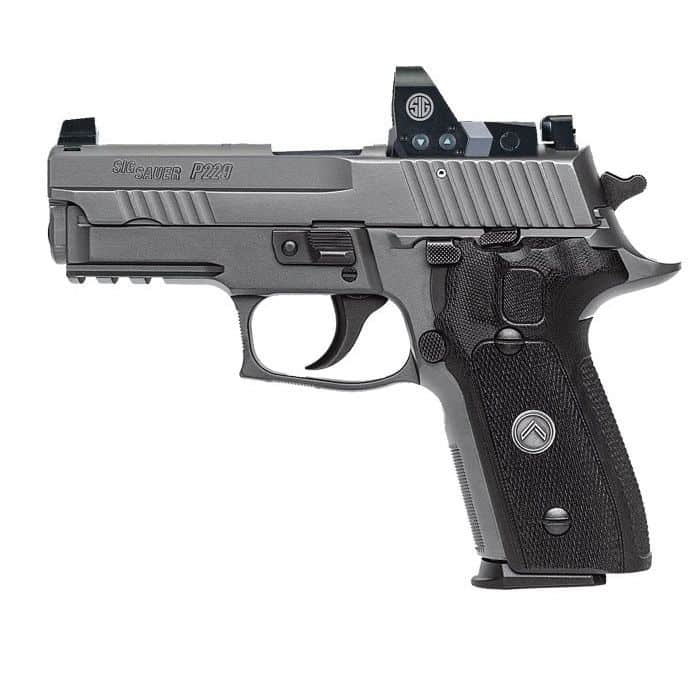
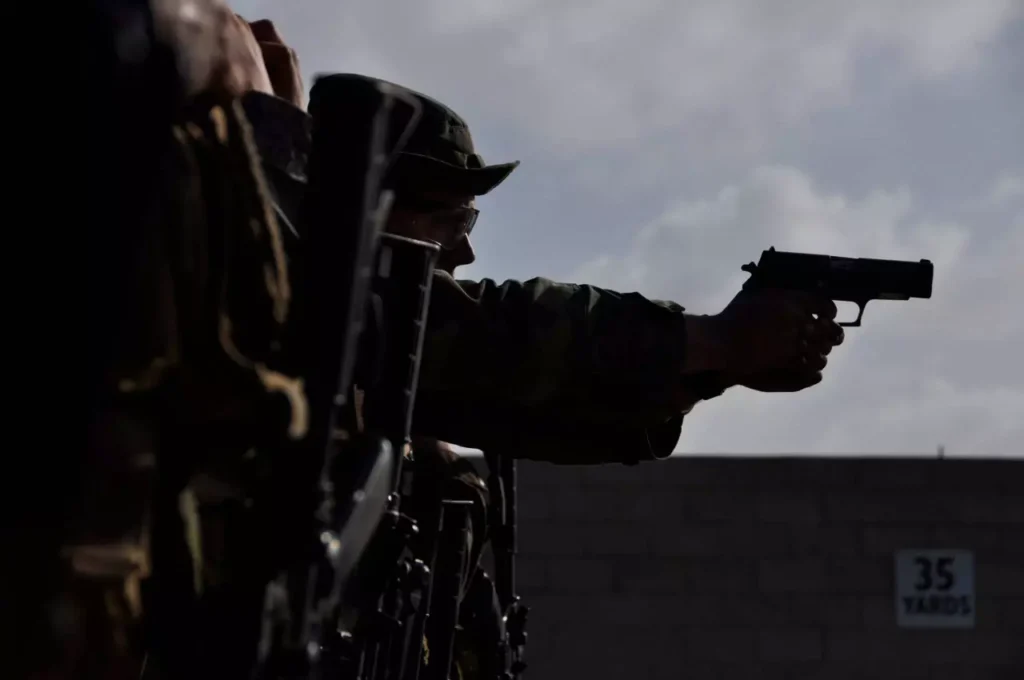
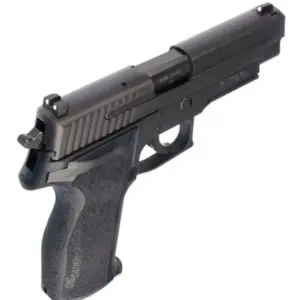
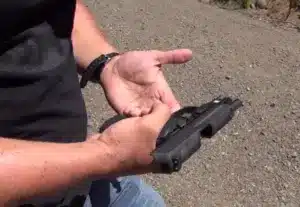

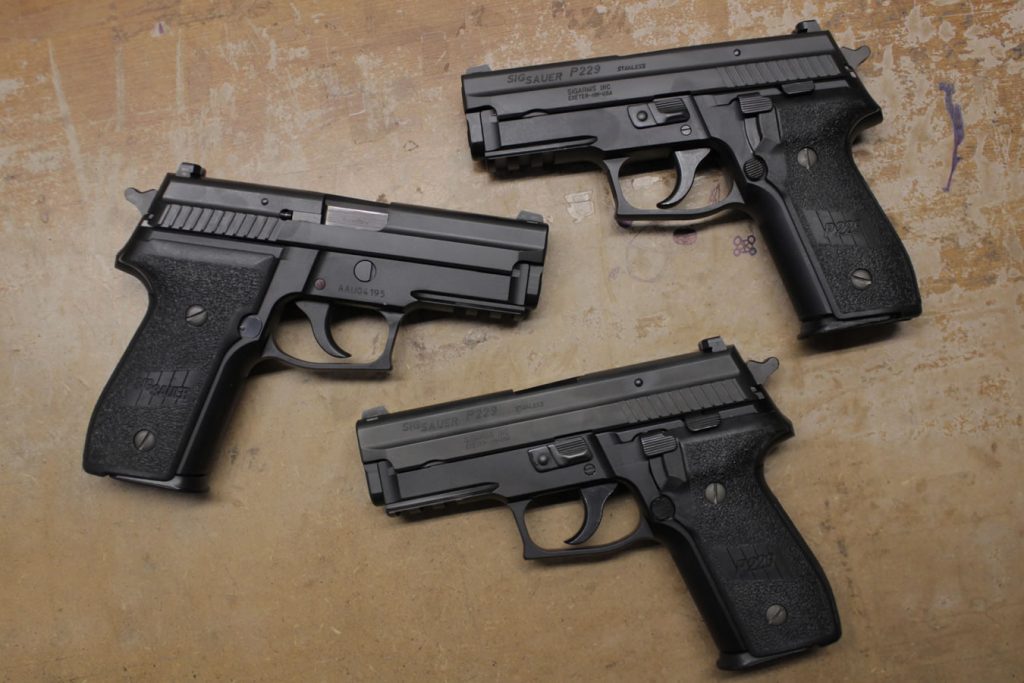











40 Responses
So I see the majority of the dimensions are the same. My dilemma here, is I bought my dad a holster designed for a 226….. he has a 229….. did I make a big mistake or can the 229 still fit in the 226 holster??
Great Article. I test fired both in 9 mil that was all they had available. I prefer the 357 sig of the 3 calibers. I purchased the new 226 in 9 mil just to add to my collection. I prefer 3 fingers around the grip than having 2. comfort relates to accuracy specifically on second and 3rd shots. even thought the recoils are negligible in math. They are recognizable when the weapon does not seat properly fits in ones hand. Over all fantastic article it should help out those who are not sure. FYI Air Marshalls use the P226 in 357 sig. soon to be going to P320 9mil
I will take my p229 40 over any other then if you get into bigger handguns. Lile a 50 cal . Next to that for mid size hand gun I pick glock 23 9 mm not as much knock down power but very lite to carry close to my sig 40 great accuracy and not to big to carry..
I was debating between the 229 and 226 Legion models. This article helped a great deal. I bought the 229. It is an awesome gun. Truly a work of art, smooth as silk to fire and deadly accurate. I may still get a 226 Legion eventually, just to have it as an investment and as a bedside home defense weapon with the rail light. I think these guns may rise in value.
I own 6 P229s,2 in 9mm and the other 4 with the convertible 357sig/.40cal option,The 229 is my everything pistol-conceal carry,home protection,and whatever else comes along.Never have I been disappointed with a failure to fire.Mine are all German framed(early model)229s,I believe that the German framed models were the crest of quality.I practice regularly with the 229s,finding Sellier and Bellot the best practice ammo,cleaner and more consistent than other ammo.The 229s prefer a slightly hotter than normal load ammo,+P ammo for defensive purposes.Like I stated-never a failure in years,I will have my 229s for a long time to come.
Great article except one part. The sig sauer was not replaced by the glock 19 because of any lacking of quality or being out shot by the g19. Every us navy seal carrys whatever they want on an individual level and customize their own sidearms to however they see fit to fit each seal like a glove. The glock 19 was simply a less expensive dust collector to keep on a shelf in an armory. They just couldn’t keep replacing sigs every few months when seals lost their sidearms in the field during combat. The article you wrote however is an excellent source of information, I’m looking at getting a lightly used p229r in 9mm from peakfirearms.com they have it at a steal for 489.99. Gonna jump on that asap.
Great artical! Very helpful. Love sigs but was trying to figure out what the difference was. Apparently not much. Thanks
Mike, congrats on a well written piece…physics don’t lie. One of the best articles I’ve read in a long time because it was based on data and prudence not opinions or conjecture. Thank you for bringing level-headeness to the forefront.
Excellent article, thank you Mike! I have been racking my brain for couple of days now whether I chose a P226 or a P229. After reading a bunch of articles about the two pistols, yours is definately the “cherry on the cake”, considering there are some really tiny specs differences between the two when shooting and carrying, my choice goes to the P229 Legion model. Anew a very accurate article.
Outstanding, I always wanted a 226, but after reading this I went for the 229 in .40 S&W.
Thanks for the detailed article.
Great article. Would love to have your analysis of P229 vs P320 X-Carry. I recently bought P226 Legion SAO and P320 X5. And can see the value of the X-Carry. My wife prefers full size 9mm
This is exactly the debate I am having with myself right now. Looking at a P226 extreme or a P229 Classic Carry (Talo) or an M11-A1. P229 Classic Carry (Talo) and the M11-A1 are the same money, the P226 is $100 more. All feel good in my hand, and all shoot great. This will not be a carry pistol for me–strictly for the range. This will be my only SIG–the others that I own are Glocks.
One more thought…IMMHO, my perfect gun that would make the angels sing if I Sig ever made one would be a P229 Rx Legion, single stack with a SA triger….just sayin..
My first Sig was a W. Greman p226 and loved it. (Like my first red headed girl friend ). Trying to decide between my needs and wants, I choose the P229 RX Legion. I am really in love now, (not the puppy love as before).
Great article.The facts are well presented.
Great article! Thanks for making it easy to understand. Looking to buying my first pistol and this answered a lot of the questions I had.
It is great to see an article that isn’t just another cosmetic review but actually provides interesting and useful data. I own a P226 and a P229. In fact, I also own a P239 so I have the full range of classic P gun sizes, all in 9mm.
This may be obvious, but of the three pistols the P229 is the Goldilocks model; not too big to carry IWB and not too small to comfortably handle recoil. The P226 is an awesome shooter and using Mec-gar 18 rd. flush mags gives it a capacity advantage over the P229 for carry. But I found it too heavy and bulky to easily conceal. The P226 is now my nightstand gun with rail light and 20 rd. mags. The P229 can easily conceal IWB with flush 15 rd. mags and use the P226 20rd. mags as reloads. P226 mags fit the P229 just fine. The P239 is single-stack and conceals even easier but is limited to 8+1 with flush mag.
The P229 is the most versatile of my three Sigs and by far the best choice if you can only have one Sig. I honestly don’t notice much if any difference in felt recoil between the P226 and P229. If you want to add a bit more muzzle weight to soften recoil more you can get a solid steel guide rod for $23 from Galloway Precision (https://gallowayprecision.com/sig-sauer/p229/solid-steel-guide-rod-for-sig-p229-pistols/).
Mike,
That was an exceptional comparison. After seeing the negligible differences has helped me make the decision to move toward the P229. I’ve been eyeing up the Legion P229 SAO. Currenlty I have the P239 DA/SA and this switch to a single action, is another decision consideration when I make my new purchase. I am used to the DA/SA after years of practice and carrying. I can see the benefits of a single action handgun and wanted to get Your thoughts on making that switch?
Thanks,
Pete
Gotta say, well-researched and -written article, with many valid points.
I happen to own variants of both (226 Elite Enhanced & 229 Scorpion, in 9mm), and my experience with them MOSTLY mirrors the data presented.
However, the numbers only present half of the equation – there is no substitute for hands-on experience. I shoot and enjoy both, am accurate and fast on target with both, but…
Ultimately, the 226 just fits better and returns to index faster, whereas the 229 conceals better.
As with anything else, YMMV.
Keep your powder dry.
As has been stated by other commenters, great job on the comparison. The balance of facts (data) and personal insight is refreshing. I would love to see a comprehensive (all current production models) web-based application that allowed users to compare any two handguns, with guidance written in this style.
To get an idea of the application, try visiting CameraDecision.com A similar app for handguns would likely be a winner with both users and advertisers.
Thanks,
David
Alex, sorry for the late reply. Here’s a link to an article which, while not necessarily for beginners per se, might make a lot of sense considering its target audience: https://gunnewsdaily.com/10-best-handguns-women/
Hope you like it. Glad you liked this article.
Hello. I was wondering if you had articles on a beginner with hand guns. I have heard I should be looking at glocks, but I found the Sig P229 more comfortable in my hand and actually revolvers even a bit more.
I would appreciate any advice you may have as i really enjoyed this article and would love to read more articles by you.
Thank you
Alex
I appreciate your in depth review, but offer up that you didn’t consider the shooter with the lesser strength grip, i.e. my wife and such others. Even the little difference in recoil can be a considerable difference for them. Having the better front end weight and the longer grip could matter to them as well. My wife has a 226 MK25 and absolutely loves it and does very well shooting it. She was wondering about the 229 because of the praises she has heard about it. I will show this to her and it will help in her considerations. I don’t see the benefit out weighing the cost to switch myself.
On the fence on whether to get a 226 or 229 – was slightly leaning toward 229, thanks for making the decision easy. Good write-up.
I’ve been carrying a full size Kimber .45. That was a mistake. I’ve decided to purchase the Sig 229 in .357 sig to replace it. Thanks for the info.
Great article. I have an m11-a1 and a p229ase stainless elite talo edition. Love them both. I was thinking about the mk25 just because it is a full size, with the navy anchor engraved I think looks cool. After reading your article there seems no shooting benifit of the 226 for me. So I may pass on purchasing the p226. Thanks for the info.
Eric, thanks for reading. I’m sure your wife will appreciate if you let her carry one of your SIGs, so I don’t think you wasted money. Whether having both is practical or not totally depends on your situation. To be honest I’d buy both if I had the money (if only for bragging rights lol).
Dave, thanks for reading. Definitely no practical reason to buy a P226 if you already have a P229.
Great article! I really appreciated your thoroughness. I already have a P229 and love it. I had an opportunity to buy a new P226 for a great deal, and so I bought it. It’s not the MK-25, but the standard California compliant Nitron model (so’s my 229.) I hope I didn’t waste my money by duplicating guns. From your article, it sounds like I may have. Oh well, if that’s true, I can let my wife use one while I use the other.
after reading the whole article (very well done and easy to follow) I’ve made up my mind. I’m gonna buy a 9mm P226 because I’m a maniac and don’t do what the math says I should. (It’s actually because I just really want the extra-cool MK25, but that’s not the point.)
I read the article even though I already own or have owned both of these. Still I found your conclusions sensibility and well written. Wish more gun writers could present their opinions and data as well as you did. Thanks, Joe
Thanks for the clear and informative article. Being an engineer I followed the math easily but also really appreciated the common language descriptions too. Extremely well done comparison.
Thanks
Steve Grant
Thanks for reading through the article, Steve. Glad you liked it.
-Mike
It’s be nice if the pictures and graphs were visible